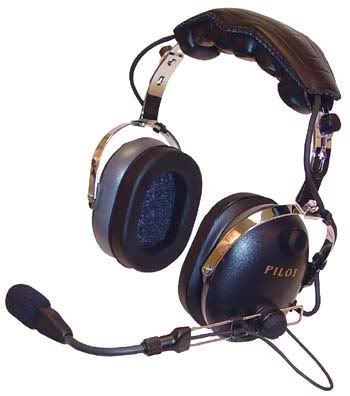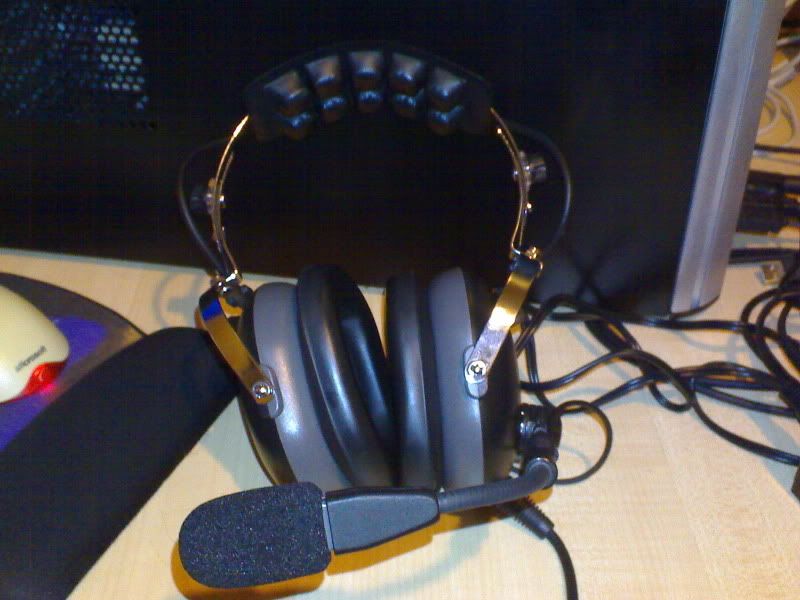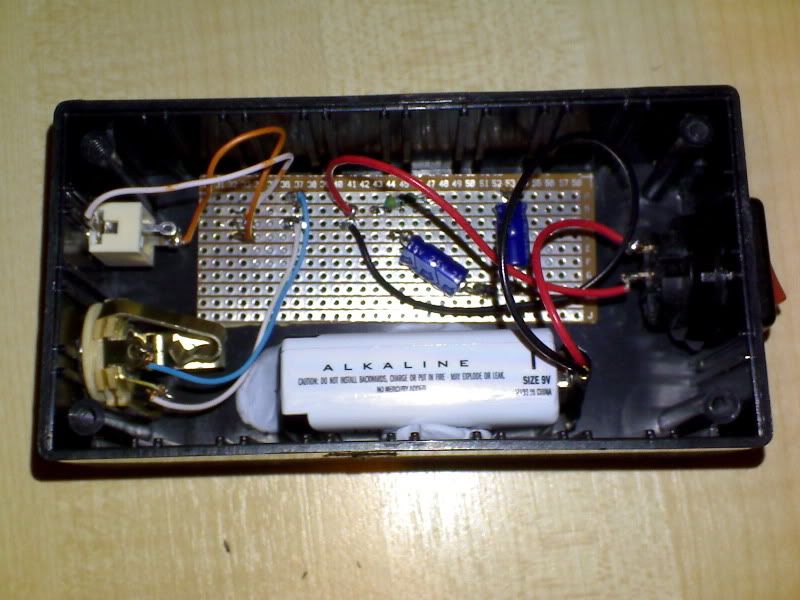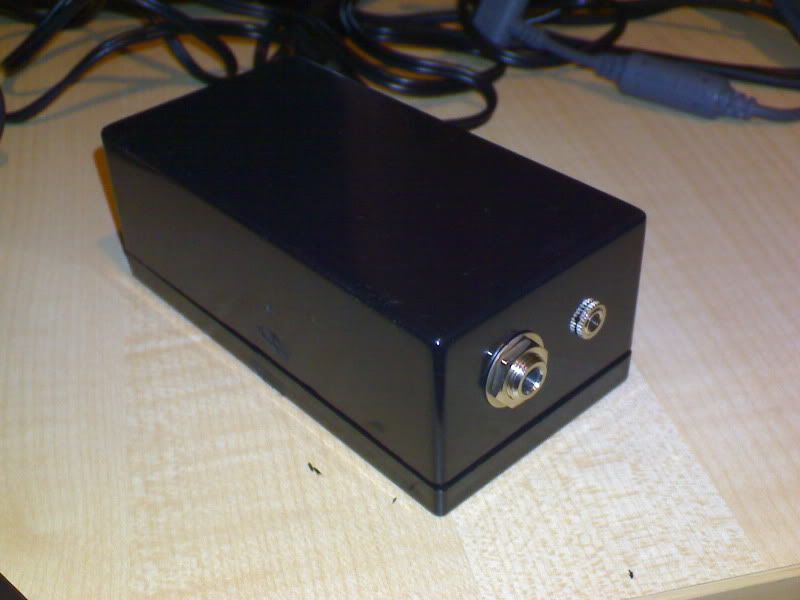Boy did I get a shock when I got Microsoft FlightSim 2004... lots of pretty pictures and fairly accurate planes and flight dynamics and running nice and smooth.
I figured it would be a good way to 'practice' my flying on bad weather days etc, and when trying to run through drills and checklists.
So I 'geeked out' and went and bought a flight yoke:

and some rudder pedals:

And doing some online flying, its nice to be able to communicate with other pilots without having to stop everything and type in the chat box... so voice comms is a must.
I already had a PC headset (with a mic) that I used to use for talking smack while playing counterstrike etc. but I found that after several hours of flying, my ears would get a little sore, due to their 'on-ear' design. In a flash on genius, I thought "Hmmmm, I wonder if I can use my nice comfy aviation headset instead?"
So for those out there that use a flightsim and also fly in the real world and/or actually have 'real' aviation headsets... I have figured out how to use an aviation headset with the PC...
Now, I have a Pilot Avionics PA 11-60...


Not the worlds greatest aviation headset... but I'm going to treat myself to a nice noise canceling one when I get my license. Anyway... I figured I could either buy an adapter (something like this), but they seem to average around US$50!! or I could make one!! So I had a hunt around online.. and came up with this page and this page which showed me what i needed to know...
- Headphone can probably be connected directly to PC (assuming stereo headset)
- Microphone will need special sized jack
- Microphone probably needs amp power
So, first up I tried the headphone connection. As the headphone plug is just a standard 6.5mm (1/4" inch) plug and mine is a stereo headset, I got a simple 6.5mm stereo to 3.5mm stereo converter for just a couple of $$ from from Dick Smith. Worked like a charm, and the added noise reduction of the headset means I can actually run at a lower volume and still hear things perfectly... BONUS!
Next was the microphone. Unfortunately, as mentioned on those websites, the microphone plug was an 'odd' size... in this case 5.3mm or .210" inch. Working off the part numbers from the websites, I found some online mail order places in the US that had them for like US$2... not too bad I thought, but they wanted like US$30 to ship them! WTF?!!
So i tried some of the avionics companies in NZ (a couple out at Ardmore etc.) and they wanted some ridiculous prices like NZ$20+GST.... pfft
Luckily I then found this New Zealand based site, RS Components... they have the Switchcraft S12B for like NZ$8+GST... and if you are in AKL, you can go pick it up at the trade counter in Penrose and dont have to worry about shipping costs! It took them about a week to ship it in but was definitely better than paying US$30!
So then it was down to Dick Smith to collect the other bits and pieces I would need:
- 2x 22uF Electrolytic Capacitors (# R4086 @ $0.20/each)
- 1x 470 Ohm resistor (# R0171 @$0.28/pack of 5)
- 1x Switch (# P7699 @$1.74/each)
- 1x 3.5mm Panel mount Jack (# P1231 @$1.54/each)
- 1x Circuit Board (# H5614 @$4.94/each)
- 1x Project Box (# H2840 @$5.99/each)
Bit of soldering here... bit of soldering there... some drilling/hacking on the project box and voila... one Aviation Headset to PC Adapter for less than NZ$25!




Now, to use my headset with the PC, I plug the headphone plug directly into the PC (using the 6.5mm to 3.5mm adapter) and I then put the microphone plug from the headset into the box, and use a 3.5mm to 3.5mm cable to connect the box to the PC.
Testing show far, indicates that other uses on Teamspeak can hear me OK (One person reckons I sound like a pilot making announcements over the intercom on an airliner) and when I connected to an FSX multiplayer server, a radio check had me reading at 5.
Notes:
If I had to do it again, I would probably used a different switch. The one I chose had to be mounted before you could solder it, due to its mounting design. Not a big thing, but made it a little more challenging.
Electrolytic Capacitors are required, as other types are not polarised. This is apparently, quite important, although I am not entirely sure why. I believe it has something to do with isolating the power from the PC sound card, so it does not interfere with the power supplied by the 9V battery.
I had to trim the circuit board down to fit it in the box, as I only required a small section of it for this really simple circuit and it didnt come in smaller sizes. Using a Stanley knife, I simply scored the board several times, between 2 of the circuit strips, and then snapped it. In hindsight, I probably should have done this BEFORE i actually soldered it all together, in case the board snapped badly, breaking the circuit.
Project boxes are a real P.I.T.A. to cut holes in... however, a drill with good bits, a sharp pair of scissors, a Stanley knife and a lot of patience will work. Take your time and measure often, as if you make the hole too big for your socket/switch, you're screwed!
Pros:
- The 24db NRR of the headset means I cannot hear the wife yelling at me that I need to get off the computer and cook dinner/mow the lawns/wash the car/come to bed
- Don't get sore ears from the 'on ear'-type headsets pushing against my ears on long flights
- Good quality headphones and microphone
- Added realism
- Fun! Yay, I get to use my multi-meter and soldering iron
- The 24db NRR of the headset means I cannot hear the wife yelling at me that I need to get off the computer and cook dinner/mow the lawns/wash the car/come to bed = T.R.O.U.B.L.E.
- Requires some electronics know how (and the ability to solder)
- Availability of parts. Unfortunately, the mic jack is quite difficult to get.
- Cost, you can probably get a USB headset for the cost of the parts (NZ$25). Not to mention the headset itself which was well over $150 when I got it about 3-4 years ago

4 comments:
Way to go! and cool! (can we still say cool?) Is that still hip? ;)
Also, have you seen this airport???
http://uk.youtube.com/watch?v=zAfQwDizpRo
I want to take a Holiday there!!!
Paul
Yes... Princess Juliana International Airport at St. Maarten is definitely a popular spot :)
I'd like to hear your thoughts on simming and how it relates to learning the real thing.
I've found it useful as a procedural trainer. Like simulating forced landings and having to run through trouble checks while flying the aircraft. I found it easy to learn the forced landing procedure, but having to work through it and fly the aircraft at the same time was causing me issues... practicing on the sim helped a lot.
I have been told its also very useful for instrument training, and learning the techniques required. Which is backed up by the fact that you can use a (certified) Sim, like the one at Waikato, for part of your instrument flight training etc.
For basic handling though, it is a little less useful, as you do not get the 'tactile' response from the aircraft. ie. You cannot 'feel' the necessary rudder pressure, or the back pressure etc. and of course you miss out on the sensory feelings from moving in 3 dimensions... so steep/max rate turns are a little less interesting ;)
I would still recommend it, as it allows you to practice drills without having to burn holes in the sky... and it impresses your instructor when you show up having memorised checks and flows really quickly :)
Post a Comment